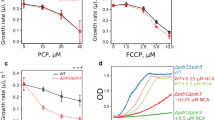Abstract
The paper describes the selection of chromate-resistant mutants of the yeast Pichia guilliermondii with a higher chromate-reducing activity and reports the EPR-study of Cr(V)-generation in the extra-cellular medium during the reduction of chromate by the yeast culture. It is shown that the reduction of chromate to Cr(III) species runs through the extra-cellular generation of Cr(V)-intermediate(s), thus supporting the assumption about the existence of an extra-cellular pathway of Cr(VI)-reduction. Furthermore, it is demonstrated that the chromate-resistance phenotype of tested mutants correlates with a lower stationary level of Cr(V)-species in the medium. It is thus suggested that isolated mutants can be used as sources of Cr(III)-biocomplexes due to their ability to effectively reduce chromate to Cr(III)-chelates with potential pharmacological applications.




Similar content being viewed by others
References
Amany MA, Sawsan KH, Mosaad A-WA (2006) Chromium-picolinate induced ocular changes: protective role of ascorbic acid. Toxicology 226:143–151. doi:10.1016/j.tox.2006.06.014
Burkholder PR, McVeigh J, Moger D (1944) Studies on some growth factors on yeasts. J Bacteriol 48:385–391
Cefalu WT, Hu FB (2004) Role of chromium in human health and in diabetes. Diabetes Care 27:2741–2751. doi:10.2337/diacare.27.11.2741
Cherest H, Davidian JC, Thomas D, Benes V, Ansorge W, Surdin-Kerjan Y (1997) Molecular characterization of two high affinity sulfate transporters in Saccharomyces cerevisiae. Genetics 145:627–635
Codd R, Lay PA (1999) Competition between 1, 2-diol and 2-hydroxy acid coordination in Cr(V)-quinic acid complexes: implications for stabilization of Cr(V) intermediates of relevance to Cr(VI)-induced carcinogenesis. J Am Chem Soc 121:7864–7876. doi:10.1021/ja9909780
Headlam HA, Lay PA (2001) EPR spectroscopic studies of the reduction of chromium(VI) be methanol in the presence of peptides. Formation of long-lived chromium(V) peptide complexes. Inorg Chem 40:78–86. doi:10.1021/ic000299m
Hepburn DDD, Xiao J, Bindom S, Vincent JB, O’Donell J (2003) Bioinorganic chemistry special feature: nutritional supplement chromium picolinate causes sterility and lethal mutations in Drosophila melanogaster. PNAS 100:3766–3771. doi:10.1073/pnas.0636646100
Honchar TM, Ksheminska HP, Patsay IO, Huta OM, Gonchar MV (2008) Assay of chromium(III) in microbial cultures using Chromazurol S and surfactants for monitoring chromate remediation processes. Biotechnology (Kiev) 1:85–94
Krumpolc M, Rocek J (1979) Synthesis of stable chromium(V) complexes of tertiary hydroxy acids. J Am Chem Soc 101:3206–3209. doi:10.1021/ja00506a013
Ksheminska HP, Honchar TM, Gayda GZ, Gonchar MV (2006) Extra-cellular chromate-reducing activity of the yeast cultures. Cent Eur J Biol 1:137–149. doi:10.2478/s11535-006-0009-3
Ksheminska H, Fedorovich D, Honchar T, Ivash M, Gonchar M (2008) Yeast tolerance to chromium depends on extra-cellular chromate reduction and Cr(III)-chelation. Food Technol Biotechnol 46:420–427
Marchart H (1964) Über die Reaktion von Chrom mit Diphenylcarbazid und Diphenylcarbazon. Anal Chim Acta 30:11–17. doi:10.1016/S0003-2670(00)88678-X
Meyer K, Bendix J, Bill E, Weyhermüller T, Wieghardt K (1998) Molecular and electronic structure of nitridochromium(V) complexes with macrocyclic amine ligands. Inorg Chem 37:5180–5188. doi:10.1021/ic980302q
Porter DJ, Raymond LW, Anastasio GD (1999) Chromium: friend or foe? Arch Fam Med 8:386–390
Puzon GJ, Roberts AG, Kramer DM, Xun L (2005) Formation of soluble organo-chromium(III) complexes after chromate reduction in the presence of cellular organics. Environ Sci Technol 39:2811–2817. doi:10.1021/es048967g
Shi X, Dalal NS (1994) Generation of hydroxyl radical by chromate in biologically relevant systems: role of Cr(V) complexes versus tetraperoxochromate(V). Environ Health Perspect 102:231–236
Stearns DM, Wise JP, Patierno SR, Wetterhahn KE (1995) Chromium(III) picolinate produces chromosome damage in Chinese hamster ovary cells. FASEB J 9:1643–1649
Vincent JB (1999) Mechanisms of chromium action: low-molecular-weight chromium-binding substance. J Am Coll Nutr 18:6–12
Vincent JB (2000) The biochemistry of chromium. J Nutr 130:715–718
Vincent JB (2003) Chromium(III) complexes. Drugs Future 28:1079–1086. doi:10.1358/dof.2003.028.11.857383
Weil JA, Bolton JR, Wertz JE (1994) Electron paramagnetic resonance: elementary theory and practical applications. Wiley, New York, p 511
Yamamoto A, Wada O, Manabe S (1989) Evidence that chromium is an essential factor for biological activity of low-molecular-weight chromium-binding substance. Biochem Biophys Res Commun 163:189–193
Acknowledgements
We thank Professor Serhiy M. Ryabchenko, Head of the Department of Magnetic Phenomena Physics, Institute of Physics, NAS of Ukraine, for the opportunity to carry out EPR-measuring on Radiopan SE/X2544. This work was carried out in the frame of the grant N304 326136 funded by KBN (Poland).
Author information
Authors and Affiliations
Corresponding author
Rights and permissions
About this article
Cite this article
Ksheminska, H., Honchar, T., Usatenko, Y. et al. The chromate resistance phenotype of some yeast mutants correlates with a lower level of Cr(V)-species generated in the extra-cellular medium. Biometals 23, 633–642 (2010). https://doi.org/10.1007/s10534-010-9317-1
Received:
Accepted:
Published:
Issue Date:
DOI: https://doi.org/10.1007/s10534-010-9317-1




